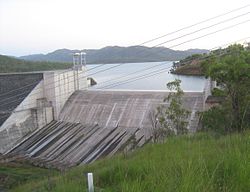Lake Awoonga
| Lake Awoonga | |
|---|---|
 |
|
| Location | Via Benaraby, Central Queensland |
| Coordinates | 24°04′31″S 151°18′29″E / 24.0753°S 151.308°ECoordinates: 24°04′31″S 151°18′29″E / 24.0753°S 151.308°E |
| Type | reservoir |
| Primary inflows | Boyne River |
| Primary outflows | Boyne River |
| Basin countries | Australia |
| Surface area | 6,750 ha (16,700 acres) |
| Water volume | 777,000 ML (630,000 acre·ft) |
| Surface elevation | 40 m (130 ft) AHD |
Lake Awoonga was formed on the Boyne River by the dam located 30 km (19 mi) from Gladstone, in Central Queensland, Australia. It is approximately 30 minutes drive from Gladstone, via Benaraby.
Lake Awoonga is the main water supply for the Gladstone region. Its recreation areas and recreational fishery are provided free to locals and tourists by the Gladstone Area Water Board.
Built across the Boyne River south west of Gladstone, the Awoonga Dam is a rockfill structure with a concrete upstream face slab. The embankment was formed from rock excavated from a quarry on the side of the dam wall. The embankment is over 650 metres (2,130 feet) in length and 54.4 metres (178 feet) in height, with a volume of approximately 2,000,000 cubic metres (71,000,000 cubic feet) of rock. The spillway’s height is 40 metres (130 feet) AHD(Australian Height Datum). This design of the current dam allows for further raising, if necessary, through the addition of gates to the top of the spillway. The maximum capacity of the present dam is 777,000 megalitres (2.05×1011 US gallons).
When full the lake is 40 m (111 feet) above sea level. Approximately 200,000 fish are released each year including barramundi and some mangrove jack. By early 2006 a total of over 2.9 million fish had been released into Lake Awoonga including 2.4 million barramundii, 470,000 sea mullet and 15,000 mangrove jack. These fish were bred at Gladstone Area Water Board's Fish Hatchery facility. The largest barramundi caught, as at November 2008, weighed in at a 36.5 kg (80.5 lbs). Lake Awoonga is one of the only dams in Australia to have been stocked with mangrove jack.
Lake Awoonga is home to an array of small animals, several of which are of conservation significance including the grey-headed flying fox and the yellow-bellied glider. Aquatic vegetation maintains an array of small animals that support the fish, eels, turtles, platypus and birds. Other species of birds, reptiles, and native fauna including bandicoots, rufous bettongs, kangaroos, wallabies, greater gliders, and brushtail possums can be found around the lake.
...
Wikipedia
